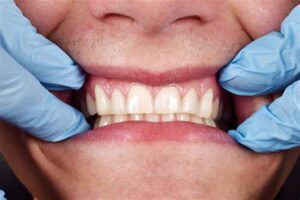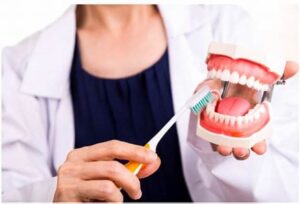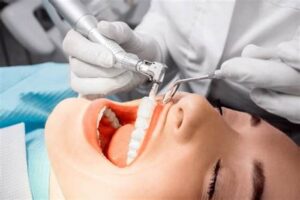Most people notice their teeth first when they smile, but your gums deserve just as much attention. Healthy gums do more than hold your teeth in place—they help protect your body from infections, too. When your gums are strong and clean, it’s easier to avoid bigger problems like tooth loss, bad breath, or gum disease.
Learning what do healthy gums look like makes a big difference. It’s not just about looks—it’s about catching early signs that something might be wrong before it gets serious. A quick glance in the mirror could tell you more than you think.
If your gums start to change color, feel tender, or bleed often, that could be a sign they need more care. But when they’re in good shape, your whole mouth feels better.
At Clark Pediatric Dentistry and Orthodontics, we help families understand and maintain healthy gums at every age. Paying attention to your gums is one of the simplest ways to keep your smile strong and your body healthier in the long run.
What Healthy Gums Actually Look Like
Knowing what do healthy gums look like can help you catch small issues before they turn into big problems. You don’t need special tools—just a mirror and a little time. When you check your gums, there are a few things to look for.
Start with color. Healthy gums are usually a light or medium pink. They shouldn’t look bright red, pale, or have any dark spots. The color may vary a bit depending on your skin tone, but overall, they should look fresh and even.
Next is how they feel. Gums that are in good shape are firm when you touch them—never soft, swollen, or puffy. If they’re sore, bleed easily, or seem spongy, that’s a sign something may be wrong.
Finally, take a look at how your gums sit around your teeth. Healthy gums fit tightly, almost like they’re hugging each tooth. They don’t look puffy or hang low. Instead, there’s a natural curve that follows the shape of each tooth.
If you’re wearing Braces Clark NJ families trust for straight smiles, healthy gums are even more important. They help keep everything in place and support the work your braces are doing. Keeping an eye on your gums is a small step that can make a big difference.
7 Signs Your Gums Are Healthy
Spotting what do healthy gums look like can help you stay ahead of dental problems. Healthy gums don’t just support your teeth—they play a big role in how your whole mouth feels every day. If you’re not sure where your gum health stands, these signs can make things clearer and easier to understand.
- Consistent Pink Color
Healthy gums have a steady, even pink tone. You shouldn’t see dark red areas, white spots, or anything that looks bruised. These changes in color could mean there’s irritation or infection starting to build. Everyone’s natural gum color may be a little different, but overall, they should look clean and calm—not blotchy or discolored.
- No Bleeding When Brushing or Flossing
Brushing and flossing shouldn’t cause your gums to bleed. A little pink on the toothbrush or floss every now and then isn’t normal—it’s often an early sign of gum disease. If your gums are healthy, they can handle gentle cleaning without any bleeding. If you’re wearing Invisalign Clark NJ providers recommend for straightening teeth, it’s even more important to keep your gums strong and free from irritation.
- Fresh Breath (No Persistent Bad Odor)
Bad breath that won’t go away might be coming from your gums. When bacteria builds up around the gumline, it can lead to an unpleasant smell that brushing alone won’t fix. Clean, healthy gums help keep your breath fresh and your mouth feeling good. If your breath is always off, it might be time to check in with your dentist.
- No Swelling or Puffiness
Your gums shouldn’t look big or puffy. Swelling usually means your body is trying to fight off something—like plaque or infection. When your gums are healthy, they sit normally without looking raised or irritated. Swelling can also feel uncomfortable, especially while eating or brushing.
- Firm Texture, Not Tender or Spongy
Touch your gums gently with clean fingers. They should feel firm, not soft or mushy. If they feel squishy or sore, that could be a warning sign of gum problems. Healthy gums hold their shape and don’t feel overly sensitive. If brushing lightly hurts, it’s worth getting them checked.
- No Gum Recession or Visible Tooth Roots
Your gums should cover your teeth properly. If your teeth look longer than before or you can see part of the root, your gums may be receding. Healthy gums stay in place and don’t pull back. Receding gums can leave your teeth exposed and more likely to feel sensitive to hot or cold.
- No Pain or Discomfort
Healthy gums don’t hurt. If you feel any kind of sharp, dull, or stinging pain along your gumline—even once—it could mean there’s something going on under the surface. Gums should feel comfortable all day, even when you’re eating or brushing.
Why Gum Health Affects More Than Just Your Mouth
Some people are surprised to learn that gum health affects more than just your mouth. In fact, problems with your gums have been connected to serious conditions like heart disease, diabetes, and complications during pregnancy. When gums are infected, bacteria can slip into your bloodstream and spread throughout your body.
If you’re managing diabetes, unhealthy gums can make blood sugar levels harder to keep in check. That’s why gum care is just as important as any other part of your health routine—it’s not only about brushing and flossing.
Strong gums support a stronger immune system and may lower your risk of infections in other areas of the body. Learning what do healthy gums look like is a simple way to protect more than just your smile.
Anyone wearing clear braces Toronto locals trust for a straighter smile also needs to watch for signs of gum trouble. Braces can trap food and bacteria, which means daily care matters even more.
The way you treat your gums can affect how you feel overall. A clean, healthy mouth can help you feel better head to toe—and it starts with small steps every day.
How to Keep Your Gums Healthy Every Day
Taking care of your gums doesn’t have to be complicated. A few simple habits each day can make a big difference. If you’re wondering what do healthy gums look like, the answer starts with how well you care for them at home.
Daily Brushing and Flossing
Brushing twice a day is the first step. Use a soft toothbrush and take your time—don’t rush it. Angle the brush toward your gumline and clean gently in circles. That helps remove the sticky stuff (plaque) that builds up. Flossing once a day is just as important. It cleans between your teeth where the brush can’t reach. Skipping floss can let bacteria grow and cause problems over time.
Use of Antibacterial Mouthwash
Rinsing with antibacterial mouthwash helps clean the spots you might miss while brushing or flossing. It also cuts down plaque and freshens your breath, which is a bonus.
Avoiding Tobacco Products
Smoking or chewing tobacco is rough on your gums. It weakens the tissue, slows healing, and makes gum disease worse. Staying away from tobacco can seriously improve your oral health.
Regular Dental Checkups
Even if your mouth feels fine, regular cleanings catch issues early. Your dentist can remove hardened plaque and check how your gums are doing. If you wear braces Clark NJ or Invisalign Clark NJ families rely on, cleanings are even more important.
When to See a Dentist About Your Gums
Some signs shouldn’t be ignored when it comes to your gums. Bleeding while brushing or flossing isn’t normal. If your gums feel sore, look swollen, or bleed often, it’s a good idea to make an appointment. Bad breath that sticks around—even after brushing—is another sign something might be off.
Watch for gums pulling away from your teeth or teeth that start to feel loose. Pain when chewing or sensitivity along the gumline can also point to a deeper issue.
If you’re using clear braces Toronto patients often choose for a cleaner look, these warning signs are even more important to catch early. Knowing what do healthy gums look like can help you act before things get worse.
Frequently Asked Questions About Healthy Gums
1: Can my gums be healthy even if they don’t look perfectly pink?
Yes. Gum color can vary slightly depending on your natural skin tone. Healthy gums are usually a shade of pink, but they might also have a bit of brown or darker pigment. What matters most is that they aren’t red, swollen, or showing patches that look unusual.
2: How often should I check my gums at home?
A quick look a few times a week while brushing or flossing is usually enough. Look for changes in color, texture, or if the gumline starts to look different. If anything feels off or hurts, it’s smart to book a dental visit.
3: What causes gums to bleed when brushing or flossing?
Bleeding gums are often a sign of gum irritation or early gum disease. It can happen if you skip flossing for a while, brush too hard, or have plaque buildup. If it keeps happening, it’s best to see your dentist.
4: Do braces or Invisalign make gum care harder?
Yes, they can. Braces and clear aligners like Invisalign Clark NJ patients use can trap food and plaque along the gumline. That’s why it’s even more important to brush well, floss carefully, and keep up with dental checkups while wearing them.
5: How long does it take to improve gum health?
If your gums are slightly irritated, you might see improvement within a week or two by brushing, flossing, and rinsing daily. But for more serious gum problems, you’ll need help from a dentist and possibly a longer care plan.
Take the First Step Toward Healthier Gums Today
Healthy gums are easier to spot than you might think. Once you understand what do healthy gums look like, it’s much simpler to keep track of changes and take action early. Staying on top of daily brushing, flossing, and regular checkups can help prevent bigger problems down the line.
Even small habits add up over time—and your gums will thank you for it. If something doesn’t feel right, don’t wait.
Looking for a dental team that makes gum health a priority? Visit Clark Pediatric Dentistry and Orthodontics to schedule your child’s next appointment.









